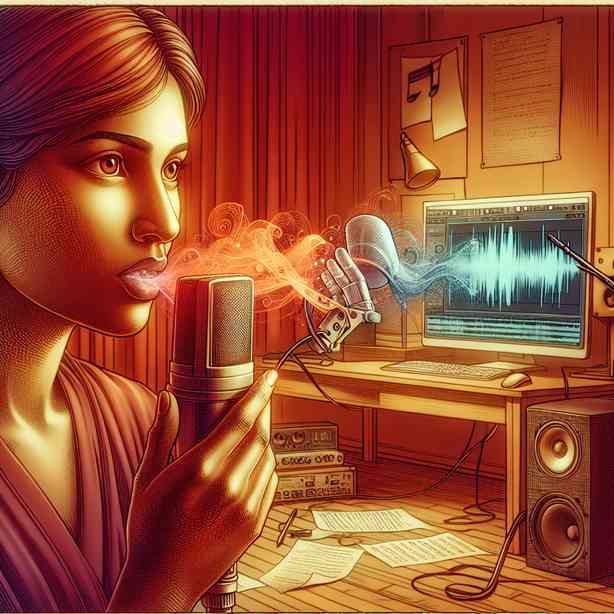
When it comes to sampling your own voice, the experience can be both fascinating and insightful. In this modern age, where technology allows us to manipulate, analyze, and even transform our voices, exploring this realm can unlock a myriad of possibilities. Through this comprehensive exploration, I aim to guide you through the process, advantages, and techniques related to sampling your voice, while also considering the emotional and psychological aspects that come into play.
First, let us understand the concept of voice sampling. At its core, sampling involves recording a segment of audio and reusing it in a different context. This is often done in music production, songwriting, or even in voice-over work. When you sample your own voice, you aren’t just creating a piece of audio; you are capturing a part of your identity and emotional expression. Each voice is unique, shaped by our experiences, culture, and personality. By sampling your own voice, you are allowing this uniqueness to shine through in a way that can connect with others on a profound level.
The process of sampling your voice can vary depending on the tools and technology you choose to use. Today, there are numerous software applications and digital audio workstations (DAWs) that facilitate voice recording and editing. Popular options include GarageBand, Audacity, and Ableton Live. For beginners, starting with a simple program can be beneficial. Once you have chosen a software, the next step is to set up your recording environment. A quiet space with minimal background noise is ideal, as this ensures a clean audio recording.
When you sit down to record, it is helpful to have a script or outline of what you want to say. This can serve as a guide, ensuring that you convey your message clearly and effectively. It’s important to take your time and be patient with yourself. Many people experience nervousness when recording their voice; this is entirely normal. However, remembering that your voice is an important part of your personal expression can help alleviate some of these nerves.
Once you have made your initial recording, the next phase is editing. This is where the magic happens. Digital audio workstations give you tools to manipulate your voice in a multitude of ways. You can trim sections, add effects like reverb or delay, or even change the pitch or tempo of your voice. The possibilities are virtually endless. Experimenting with these options can lead to surprising and delightful results. You might find that you enjoy layering different voice samples to create harmony, or perhaps you prefer a more straightforward approach that highlights the natural quality of your voice.
Sampling your voice can lead to unintended discoveries. You might notice nuances and aspects of your voice that you had never before considered. Hearing yourself from an outside perspective can be a transformative experience. It’s not uncommon to develop a deeper appreciation for your own vocal qualities, or to identify areas where you might want to improve further. This self-reflection can significantly enhance your confidence and vocal skills over time.
Furthermore, sharing your sampled voice with others can foster a sense of community and connection. In many artistic circles, sharing your work is a vital part of the creative process. It allows for feedback, collaboration, and encouragement from peers. Online platforms like SoundCloud or YouTube provide avenues for showcasing your work, enabling you to reach an audience that resonates with your message. The response from listeners can be incredibly rewarding and can motivate you to continue exploring your vocal creativity.
Another interesting aspect to consider is the psychological implications of voice sampling. Engaging in this creative process can be therapeutic. Many individuals report feeling a sense of liberation when they explore their vocal abilities. This can be especially relevant for those who may feel shy or self-conscious about their voice in everyday situations. By actively sampling and experimenting with your voice, you create space for self-acceptance and personal growth. It serves as a reminder that your voice is not just a means of communication; it is also an instrument of expression.
Additionally, sampling your own voice can lead to professional opportunities. In fields that require voiceovers, narration, and public speaking, having a portfolio that showcases your voice can be invaluable. It demonstrates your versatility and ability to adapt your voice to different contexts. As you develop your skills, you’ll find that you can tackle various genres and styles, further enhancing your appeal in the professional realm.
In conclusion, sampling your own voice is an enriching journey that encompasses a blend of creativity, self-discovery, and personal expression. It allows you to explore the depth of your vocal abilities while connecting with others in meaningful ways. Whether you turn this exploration into a personal hobby or a professional endeavor, the insights and experiences gained can be transformative. So, take the plunge, grab your recording equipment, and begin to uncover the power of your unique voice. There’s no better time to start this empowering journey than now, and who knows where it might lead you? The world is eager to hear what you have to say.


